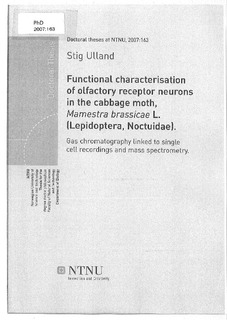| dc.contributor.author | Ulland, Stig | nb_NO |
| dc.date.accessioned | 2014-12-19T11:20:15Z | |
| dc.date.available | 2014-12-19T11:20:15Z | |
| dc.date.created | 2008-04-18 | nb_NO |
| dc.date.issued | 2007 | nb_NO |
| dc.identifier | 124132 | nb_NO |
| dc.identifier.isbn | 978-82-471-3585-3 | nb_NO |
| dc.identifier.uri | http://hdl.handle.net/11250/227945 | |
| dc.description.abstract | Most of us are well aware of the many odours surrounding us in nature and enjoy the pleasant smell of flowers or culinary herbs. In evolutionary context the sense of smell is considered as the oldest of our senses and is involved in the search for and intake of food, in reproductive and social behaviour, interspecific communication etc. Most people may not be aware of the important role of olfaction in animals like the insects. Whereas the perception of a flower fragrance in humans may be limited to “the plant smells good”, herbivore insects are able to smell not only the species but also the physiological state of the plant, being indispensable for their survival. In contrast to visual and audio stimuli that are defined by one feature, the wavelength, olfactory stimuli are characterized by several interactive features of the molecule. Thus, screening volatiles on sensory cells in order to find the most effective odorant among the enormous number in nature does not seem to be a promising approach. One of the challenges in mechanistic olfactory research is to identify the biologically relevant odorants detected by the receptor neurons (RNs) in the various model organisms. Even though the gross anatomy of the olfactory system in vertebrates and insects appear very different, like the vertebrate noses and insect sensilla, striking similarities exists as concerns some basic structures and functional principles. For instance, the sensory cells of the olfactory epithelium in the vertebrate nose are bipolar neurons with cilia embedded in mucus and an axon projecting in one of the glomeruli of the olfactory bulb, the primary olfactory centre in the brain. This corresponds to the bipolar RNs in insect olfactory sensilla, having dendrite branches embedded in the receptor lymph and an axon projecting in glomeruli of the antennal lobe, the insect primary olfactory centre. Because the insect olfactory system, including the RNs on the antennae as well as the brain, is relatively easily accessible for electrophysiological studies, insects are suitable model organisms for studying olfactory mechanisms underlying behavioural responses. | nb_NO |
| dc.language | eng | nb_NO |
| dc.publisher | Fakultet for naturvitenskap og teknologi | nb_NO |
| dc.relation.ispartofseries | Doktoravhandlinger ved NTNU, 1503-8181; 2007:163 | nb_NO |
| dc.relation.haspart | Ulland, S; Ian, E; Borg-Karlson, A-K; Mustaparta, H. Discrimination between Enantiomers of Linalool by Olfactory Receptor Neurons in the Cabbage Moth Mamestra brassicae (L.). Chemical Senses. 31(3): 325-334, 2006. | nb_NO |
| dc.relation.haspart | Ulland, S; Ian, E; Mozuraitis, R; Borg-Karlson, A-K; Meadow, R; Mustaparta, H. Methyl Salicylate, Identified as Primary Odorant of a Specific Receptor Neuron Type, Inhibits Oviposition by the Moth Mamestra Brassicae L. (Lepidoptera, Noctuidae). Chemical Senses. 33(1): 35-46, 2008. | nb_NO |
| dc.title | Functional characterisation of olfactory receptor neurons in cabbage moth, Mamestra brassicae L. (Lepidoptera, Noctuidae). Gas chromatography linked to single cell recordings and mass spectrometry | nb_NO |
| dc.type | Doctoral thesis | nb_NO |
| dc.contributor.department | Norges teknisk-naturvitenskapelige universitet | nb_NO |
| dc.description.degree | PhD i biologi | nb_NO |
| dc.description.degree | PhD in Biology | en_GB |
